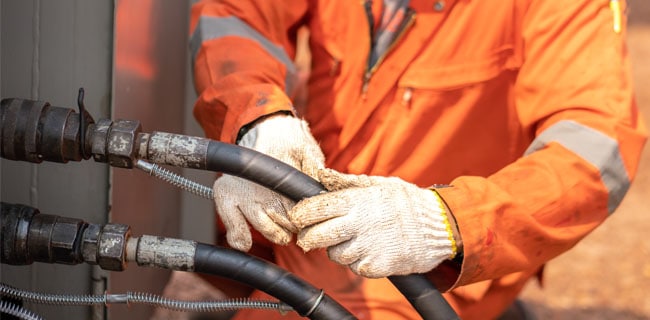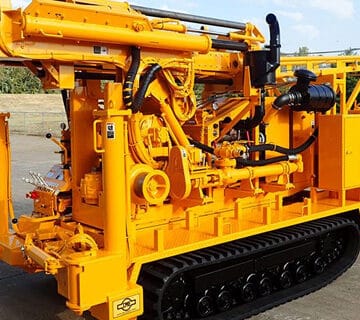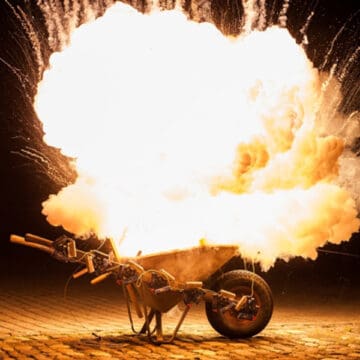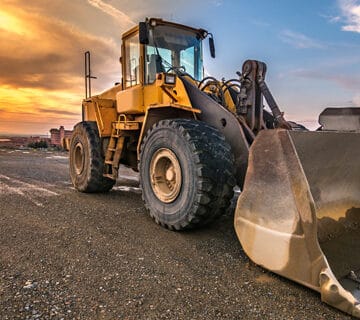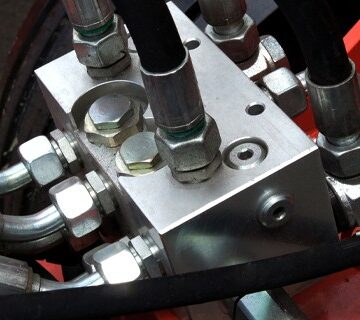Premature hydraulic hose failure is a common, but largely preventable problem that costs businesses thousands in unnecessary costs, worker injuries and production delays every year. Understanding your hydraulic hose assembly is the first step to avoiding early hydraulic hose failure and keeping your operations running smooth. To help, we offer insight on the most common hose failure causes plaguing your business, including improper assembly, poor hose routing, fluid incompatibility and more.
The Consequences of Failed Hose Assemblies on Your Business
Hydraulic hoses have a limited service life and require timely replacement and predictive maintenance for safe and reliable operation. Without regular maintenance, your business runs the risk of serious safety and productivity implications that can cost thousands.
Dangers of failed hydraulic hose assembly. Hydraulic hose failure not only slows down production, it can be dangerous if the hose contains flammable or hazardous material. Hose failure can impose dangers such as slip and fall risks, explosions and fluid burns. High-pressures hoses can also inject hydraulic fluid into exposed body parts, causing devasting injury and illness.
Operational costs associated with hydraulic hose failure. In addition to safety hazards, hydraulic hose failure poses a threat to operations as well. A failed hose line can bring production to a screeching halt, resulting in lost productivity, wasted material and the potential for environmental damage. Other impacts include:
- High hydraulic fluid consumption
- Inefficient machine operation
- Safety and accident liability
- Premature equipment failure
- Poor product quality
- Increased capital costs
Fact: One leaked drop of hydraulic fluid per second is equal to 420 gallons over a 12-month period. (Source: Machinery Lubrication)
Have questions on improving the safety and efficiency of your hydraulic hose systems?
Give us a call at 314-638-6500 OPTION 4.
Top 11 Reasons Why Hose Assemblies Fail (prevention tips included)
Stop cutting your hydraulic hose’s service life short. Learn more about the eleven most common causes of premature hose failure and get the most out of your hoses’ service life.
01. Improper assembly and fittings
For a hydraulic hose to operate safely and effectively, it must be assembled correctly from the start. Choosing the wrong components and fittings can result in poor holding strength, leaks and blow outs. Contamination from metal particles and debris from hose assembly can create small fractures in the hose or contaminate the hydraulic system.
Related: Superior’s Simple Guide to Understanding Hydraulic Hose and Fitting Assembly
02. Improper routing
Premature hose failure is often related to improper hose routing. By not planning out a route that allows for easy connection and access for maintenance, repair and service, you run the risk of hose failure resulting in lost productivity, increased safety hazards, wasted material and potential for environmental damage.
Related: Learn Better Hydraulic Hose Assembly with Proper Routing Techniques from Eaton
03. Tube erosion
Tube erosion is when areas of a hose begin to break down, or erode, due to concentrated high-velocity streams of fluid or particles. Over time, those concentrated levels cause premature wear and tear on the interior walls of the hose itself, often causing external leakage.
04. Pressure surges
Whether the pressure surge is due to rising pressure, changes in velocity or surge waves, each one can cause dangerous and irreparable damage like hose bursts, equipment damage or serious injury.
05. Fluid compatibility
Use of incompatible fluids can weaken the interior of the hydraulic hose, or inner tube, causing it to deteriorate, swell and delaminate. When this occurs, you run the risk of leakage or a burst hose.
06. Minimum bend radius
The degree of bend in a hydraulic hose can cause hose assembly failure if the minimum bend radius is not met. Tubes and covers can actually rip apart or kink, resulting in leakage or restricted flow when routing, length, fittings and bend radius don’t comply with recommendations.
07. Insertion depth
Fittings must be pushed onto a hose completely, called insertion depth, in order to provide grip and a secure fit. When fittings are not properly applied to a hose assembly, the result can be devastating. Equipment failure, injury and risk to the environment are just a few of the dangers associated with inadequate insertion depth.
08. Operating temperatures
Operating at maximum temperatures and maximum pressures are not recommended for safe and reliable hydraulic hose use. Temperatures that are rated too high or too low for conveyance can impact flow and degrade the hose’s rubber, reducing overall service life.
09. Abrasion
Hydraulic hoses that rub against other objects or hoses are at risk of abrasion that over time wears away the hose cover and reinforcement layers. Properly installed, protected and routed hose assemblies will perform better, last longer and operate more safely.
Related: Choosing the Right Hydraulic Fittings Using the STAMPED Method
10. Chemical exposure
Using the wrong hose material, fittings, inner tubes, seals and O-rings with certain types of chemicals can degrade the hose assembly, causing extreme danger to bystanders and the environment. Review the chemical resistance requirements of your applications and hose assemblies before selecting hose components.
11. Dry air
When dry or aged air is passed through the inner tube of hoses, it can cause tiny cracks that often go unnoticed causing slow leaks or complete failure.
Prevent Failed Hose Assembly with Professional Advice from the Experts
When hydraulic hoses fail, it can usually be attributed to one of the eleven reasons we covered above. Often, failure could have been avoided with proper operator training. Any worker that assembles, works with, or repairs hydraulic hose assembly should be able to:
- Understand and identify the different types of industrial and hydraulic hoses
- Understand the uses and limitations of each hose
- Select the right hose and fittings to satisfy application requirements
- Know when to replace worn hoses, fittings and other hydraulic hose components
When in doubt, speak to a hose specialist for professional and expert advice about the type, style and selection of hydraulic hose assemblies right for your application.
Give us a call at 314-638-6500 OPTION 4 and speak to a knowledgeable representative today!
Superior Industrial Supply knows how important it is to have durable and reliable equipment for your most demanding applications. It’s why we specialize in hydraulic hose assembly and repairs. Give us a call at 314-638-6500 OPTION 4 or 800-783-6501 and let us know how we can help you find the products, services and advice you need to do just that.
Don’t forget to visit our website or read our blog for more information!

